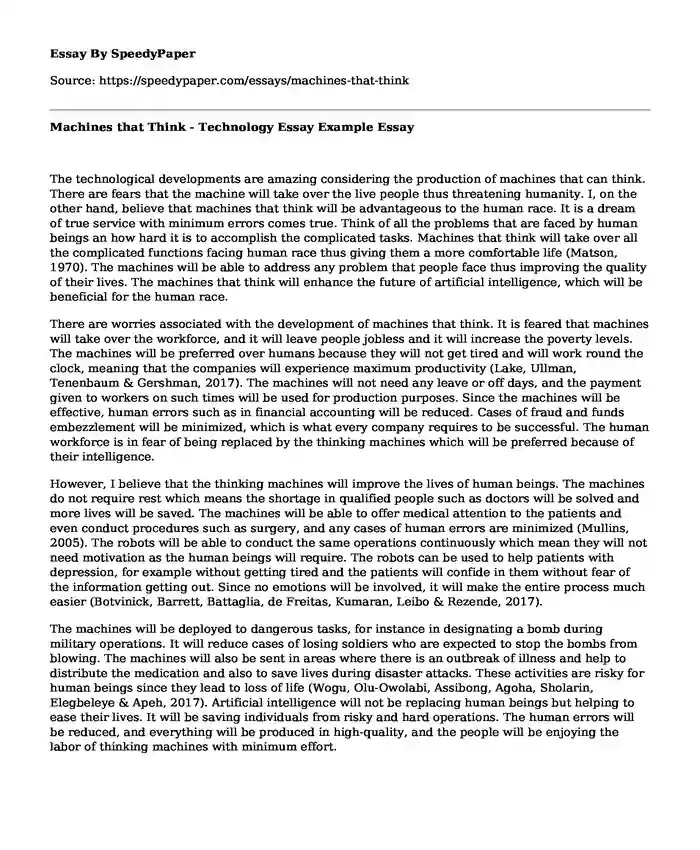
| Type of paper: | Essay |
| Categories: | Information technologies Artificial intelligence |
| Pages: | 3 |
| Wordcount: | 711 words |
The technological developments are amazing considering the production of machines that can think. There are fears that the machine will take over the live people thus threatening humanity. I, on the other hand, believe that machines that think will be advantageous to the human race. It is a dream of true service with minimum errors comes true. Think of all the problems that are faced by human beings an how hard it is to accomplish the complicated tasks. Machines that think will take over all the complicated functions facing human race thus giving them a more comfortable life (Matson, 1970). The machines will be able to address any problem that people face thus improving the quality of their lives. The machines that think will enhance the future of artificial intelligence, which will be beneficial for the human race.
There are worries associated with the development of machines that think. It is feared that machines will take over the workforce, and it will leave people jobless and it will increase the poverty levels. The machines will be preferred over humans because they will not get tired and will work round the clock, meaning that the companies will experience maximum productivity (Lake, Ullman, Tenenbaum & Gershman, 2017). The machines will not need any leave or off days, and the payment given to workers on such times will be used for production purposes. Since the machines will be effective, human errors such as in financial accounting will be reduced. Cases of fraud and funds embezzlement will be minimized, which is what every company requires to be successful. The human workforce is in fear of being replaced by the thinking machines which will be preferred because of their intelligence.
However, I believe that the thinking machines will improve the lives of human beings. The machines do not require rest which means the shortage in qualified people such as doctors will be solved and more lives will be saved. The machines will be able to offer medical attention to the patients and even conduct procedures such as surgery, and any cases of human errors are minimized (Mullins, 2005). The robots will be able to conduct the same operations continuously which mean they will not need motivation as the human beings will require. The robots can be used to help patients with depression, for example without getting tired and the patients will confide in them without fear of the information getting out. Since no emotions will be involved, it will make the entire process much easier (Botvinick, Barrett, Battaglia, de Freitas, Kumaran, Leibo & Rezende, 2017).
The machines will be deployed to dangerous tasks, for instance in designating a bomb during military operations. It will reduce cases of losing soldiers who are expected to stop the bombs from blowing. The machines will also be sent in areas where there is an outbreak of illness and help to distribute the medication and also to save lives during disaster attacks. These activities are risky for human beings since they lead to loss of life (Wogu, Olu-Owolabi, Assibong, Agoha, Sholarin, Elegbeleye & Apeh, 2017). Artificial intelligence will not be replacing human beings but helping to ease their lives. It will be saving individuals from risky and hard operations. The human errors will be reduced, and everything will be produced in high-quality, and the people will be enjoying the labor of thinking machines with minimum effort.
References
Botvinick, M., Barrett, D. G., Battaglia, P., de Freitas, N., Kumaran, D., Leibo, J. Z., ... & Rezende, D. J. (2017). Building machines that learn and think for themselves: Commentary on lake et al., behavioral and brain sciences, 2017. arXiv preprint arXiv:1711.08378.
Lake, B. M., Ullman, T. D., Tenenbaum, J. B., & Gershman, S. J. (2017). Building machines that learn and think like people. Behavioral and Brain Sciences, 40.Matson, K. (1970, January 01). 2015: WHAT DO YOU THINK ABOUT MACHINES THAT THINK? Retrieved October 19, 2018, from https://www.edge.org/annual-question/what-do-you-think-about-machines-that-think
Mullins, J. (2005). Whatever happened to machines that think?. New Scientist, 186(2496), 32-37.Wogu, I. A. P., Olu-Owolabi, F. E., Assibong, P. A., Agoha, B. C., Sholarin, M., Elegbeleye, A., ... & Apeh, H. A. (2017, October). Artificial intelligence, alienation and ontological problems of other minds: A critical investigation into the future of man and machines. In Computing Networking and Informatics (ICCNI), 2017 International Conference on (pp. 1-10). IEEE.
Cite this page
Machines that Think - Technology Essay Example. (2022, Aug 22). Retrieved from https://speedypaper.com/essays/machines-that-think
Request Removal
If you are the original author of this essay and no longer wish to have it published on the SpeedyPaper website, please click below to request its removal:
- Free Essay Sample on How to Survive a Breakup
- Essay Example on Project Management
- Free Essay on the U.S. Military Operations, Battles, and Campaigns - Land, Sea, And Air
- Essay Sample on Health Hazards in Manufacturing Industry
- Mandatory Minimum Sentencing Law
- Paper Example: Healthcare Condition Description
- Free Essay Sample: The Impact of Online Applications on Human Interaction and Cognition
Popular categories




